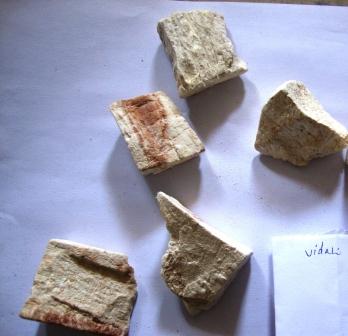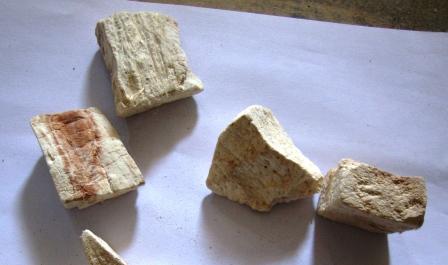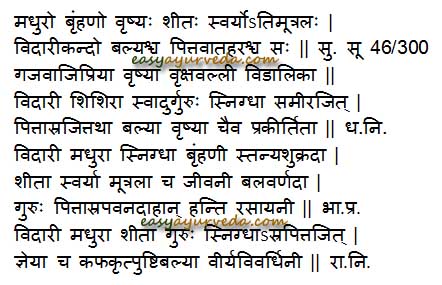Vidarikand Pueraria tuberosa Uses, Research, Side Effects
Indian Kudzu – Pueraria tuberosa is an Ayurvedic herb used for the treatment of hepatic diseases, discoloration of the skin, fever, to improve the breast milk and as general tonic and improve the body mass.
Latin name- Pueraria tuberosa DC
Some consider Ipomea digitata as Vidarikand.
Family- Leguminosae (Simbi kula)

Table of Contents
Vernacular names
Names in different languages:
Hindi name: Vidarikanda, Bidari Kand, Bidhari Kand
English name: Indian kudzu
Assamese name: Bhedeleton, Bhuikumra
Bengali name: Vidari, Bhumikushmanda, Bhuinkumra
Gujarati name: Vidarikanta, Bhonykoru, Eagio, Bhoikolu, Sakharvel
Kannada name: Nelagumbala Gudde, Gumadi gida
Malayalam name: Mudakku
Marathi name: Bhuikohala, Ghodvel
Oriya name: Bhuiankakharu
Punjabi name: Siali
Tamil name: Nilapoosani
Telugu name: Nelagummuda, Darigummadi
Sanskrit Synonyms
Bhoomi kushmanda- The rhizome has similar benefit like kushmanda fruit
Gajavajipriya, Gajishta- The plant is liked by horse and elephant
Swadukanda- The tuber is sweet
Ikshu Vidari, Ikshugandha- The tuber is sweet like sugarcane
Ksheera Shukla, Ksheerakandha, Payasvini, Ksheeravalli- The tuber exudes milk like extract
Shrestakandha- The tuber has good property
Swadu Lata, Swadu Kanda – sweet tuber
Vrushyakanda, Vrushya Valli, Vrushyavallika – Aphrodisiac
Palashika, Vidalika, Shrugalika, Kroshtri Sita, Bhu Kushmandi,
Morphology
It is a large climber with tuberous roots and stem shrubby. The leaves are 3-foliate; petioles 10-15 cm long, more or less pubescent, the stipules 4 mm. long, ovate-oblong, cordate. The leaflets are sub coriaceous, 12.5-20 by 11.5-18 cm, glabrescent above, silky beneath. Flowers are bisexual, around 1.5 cm (0.59 in) across and blue or purplish-blue in color. The fruit pods are linear, about 3–5 cm long and constricted densely between the seeds. They have silky, bristly reddish-brown hair. Seeds vary from 3 to 6 in number. The tubers are globose or pot-like, about 25 cm across and the insides are white, starchy and mildly sweet. The plant can be found in forest and river sides all over temperate India.

Well developed and matured tubers are cut into round pieces and are dried and are preserved in airtight containers. The drug retains its potency for a period of 1 year.
Hedysarum tuberosum Roxb.ex Willd is used as a synonym for the plant.
Varieties
Dh. Ni and Raja Ni – 2 types
Vidari – Pueraria tuberosa
Ksira vidari – Ipomoea digitata
Substitute
Ipomoea paniculata
Adulterant
Stem pieces of Tricosanthes cordata
Properties, part used, dosage
Properties:
Rasa (Taste) – Madhura (Sweet)
Guna (Qualities) – Guru (Heavy for digestion), Snigdha (Slimy)
Vipaka – Madhura (Undergoes sweet taste after digestion)
Veerya (Potency) – Sheeta (Cold)
Karma (Actions) – Vatapitta shamaka (reduces vitiated vata and pitta dosha)
Part used- Tuber
Dosage-
Powder- 3 to 6 g
According to Bhojana Kutuhalam eleventh chapter, Vidari is sweet, cold, heavy to digest, unctuous and alleviates pitta. It aggravates kapha and imparts nourishment, strength and virility.
Chemical composition
The tuber of the plant contains β–Sitosterol, Stigmasterol, Duidzein, Puerarin and isoflavone C–Glycoside–4’6”–Diacetylpuerarin. It also contains pure compounds, puerarin, daidzein and tuberosin.
Uses, Sanskrit verse
Uses of Vidari:
- The tuber of vidari is made into decoction and is given as a demulcent and coolant in fevers.
- The tuber of Pueraria tuberosa is peeled, bruised into paste and is used to reduce swellings of the joints.
- To improve the quantity of breast milk during lactationperiod, the powder of the tuber of Vidari is given in a dose of 4-6 g mixed with cow milk.
- The powder of the tuber of Pueraria tuberosa is given in a dose of 3-5 g with ghee or milk to improve the sperm count, libido and sexual vigor in males.
- Cold infusion of the tuber is given in a dose of 40-50 ml to strengthen liver and spleen in conditions of degeneration of hepatic and splenic tissues.
- To improve the body mass, the powder of the tuber of Indian kudz is mixed with milk and consumed regularly.
- To improve the skin complexion, the powder of Pueraria tuberosa is consumed by mixing with honey and saffron powder.

Traditional Uses of Vidarikand as per Ayurveda
Brumhana – nourishing, nutritious
Vrushya – aphrodisiac, improves vigor
Sheeta – coolant
Svarya – improves voice tone and quality
Atimutrala – diuretic, induces urination
Balya – improves strength and immunity
Stanyada – improves breast milk production
Shukrada – improves sperm and semen quantity and quality
Balada – improves strength and immunity
Varnada – improves skin complexion
Asrapittajit – Useful in bleeding disorders such as nasal bleeding, heavy periods, etc
Adverse effect
No adverse effect is known or reported after the normal use of vidari.
Not ideal in Kapha imbalance disorders such as obesity, asthma, cough, cold.
Interaction with medicines, supplements
Can this be used while taking Homeopathic medicine?
Yes. This product does not react with homeopathic medicine.
Can this medicine be continued while taking supplements like multivitamin tablets, Omega 3 fatty acids etc?
Yes. Generally, this product goes well with most dietary supplements. However, if you are taking more than one product per day, please consult your doctor for an opinion.
With western
medicines
Seek your
doctor’s advice if you are taking this product along with other western
(allopathic / modern) medicines. Some Ayurvedic herbs can interact with modern
medicine.
If both Ayurvedic and allopathic medicines are advised together, then it is
best to take Allopathic medicine first, wait for 30 minutes and then take the
Ayurvedic medicine.
Ayurvedic medicines
Ayurvedic medicines containing Vidari:
Vidaryadyasava: It is a Ayurveda medicine which is used to treat rheumatic and acidic complaints, digestive disorders, body pain and asthmatic complaints.
It can increase body weight.
Amritaprasha ghrita: It is a processed ghee based medicine which is beneficial in the treatment of burning sensation, fever, bleeding disorders, cough, asthma, weakness and gynecological diseases.
Prasootikamrita lehya: It is a proprietary Ayurveda medicine which is indicated in Ayurveda treatment of fatigue after delivery, restores strength and beauty.
Gopichandanadi gulika: It is an Ayurveda medicine used in treatment of fever in children.
Herboy capsule: It is a proprietary Ayurveda medicine which helps in improving the general well-being, vigor and vitality, and retains cheerfulness all through the day.
Vimfix tablet: It is a proprietary Ayurveda medicine which is used for the treatment of erectile dysfunction, lack of libido, premature ejaculation etc.
Research
Research articles related to Pueraria tuberosa:
Anti- inflammatory action: A study has reported the antioxidant potential of methanolic extract of tubers of Pueraria tuberosa (PTME) and inhibitory role of tuberosin on lipopolysaccharides-induced expression of inducible nitric oxide synthase in macrophages in an in vitro study model. Here, the effect of PTME has been explored on carrageenan-induced inflammatory changes in rats. The PTME significantly prevented carrageenan-induced decline in GSH content, lowering of catalase and SOD activity, and rise in LPO and CRP in rats in a time-dependent, sequential manner. Thus, it could be suggested that the anti-inflammatory role of PTME is primarily mediated through its FR scavenging potential.
Anti- microbial action: The tuber plant of Pueraria tuberosa plant material s (leaf, stem, tuber and root) extracts were tested for their antibacterial activity against Escherichia coli, Bacillus cereus, Salmonella paratyphi, Staphylococcus aureus and fungus Candida albicans, Aspergillus fumigatus and Alternaria solani using agar diffusion assay. These both activities by using ethanolic and methanolic extract of different parts of plants were shown.
Antioxidant effect: The antioxidant potency of P. tuberosa was investigated for the first time. Total antioxidant capacity was determined using an ABTS*+ assay. Lipid peroxidation was assessed in terms of thio barbituric acid-reactive substances by using egg-yolk homogenates as lipid-rich media. Superoxide radical scavenging was measured using riboflavin-light-nitro blue tetrazolium (NBT) assay. Hydroxyl radical trapping potential was determined by evaluating hydroxyl radical induced deoxyribose degradation using thiobarbituric acid method. In order to assess the metal chelation property, hydroxyl radical induced deoxyribose degradation was evaluated in the absence of ethylene di-amine tetra acetic acid. Both hexane and methanol fractions inhibited lipid peroxidation and also chelated the iron, showing potent antioxidant property.
Classical categorization
Bhavaprakasha- Guduchyadi varga
Dhanvantari Nighantu- Guduchyadi varga
Kaiyyadeva Nighantu- Oushadhi varga
Raja Nighantu- Moolakadi varga
Susruta – Vidarigandhadi gana, Vallipanchamula
Charaka – Brimhana varga, Varnya ahakashaya, Kanthya mahakashaya, Snehopaga mahakashaya
Scientific classification
Kingdom: Plantae
Order: Fabales
Family: Fabaceae
Genus: Pueraria
Species: P. tuberosa
Word derivation
Word Derivation of Vidarikanda:
The derivation of the term Vidaari is derived from the explanation “vidaarayati iti vidaari” as per Shabdakalpadruma which means that the one that causes a breakage or a crack. As in this case the tubers of the plant become huge that they tend to break the earth surface. Thus the name is conferred on it. As the tuber being the main usable part the drug is totally known as Vidaarikanda.
Collection, storage
Collection: The tubers are deeply situated and thus difficult for collection. It is easily collected from the banks of water sources like rivers, ponds, etc.
Storage: Well developed and matured tubers are cut into round pieces and are dried and are preserved in airtight containers. The drug retains its potency for a period of 1 year.
Author: Dr.B.K.Prashanth M.D (Ayu), Ph.D
E mail: [email protected]
Click to consult Dr Prashanth BK
Sthanika Karma (Systemic Action)
Internal administration-
Digestive System – Digestant, facilitates movement of doshas in normal direction, Unctuous, Stimulates the release of bile from gallbladder. Indicated in hepato and splenomegaly, constipation, dryness of intestinal mucosa, diseases of pitta origin.
Respiratory system – Expel out vitiated kaoha dosha. Indicated in Hoarseness of voice, and cough due to vata and pitta dosha.
Excretory System – Indicated in dysuria, increases urine output
Circulatory system – indicated in blood borne diseases.
Reproductive system – Aphrodisiac and stimulates breast milk production in breastfeeding mothers.
Tapakrama –Promote complexion, indicated in conditions associated with burning sensation
tvak – indicated in skin disorders
Satmikarana – Indicated in general debility, weakness etc.










